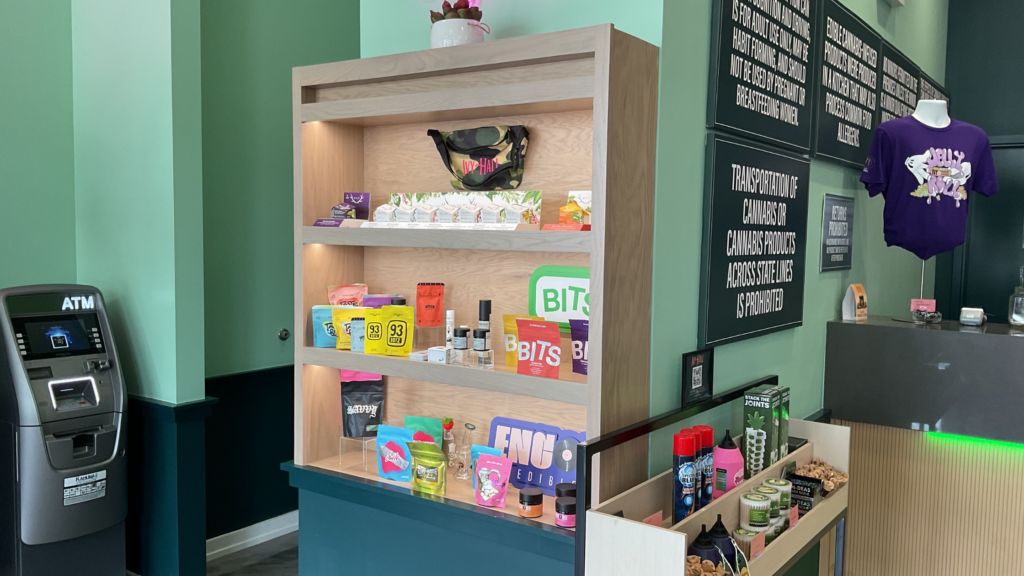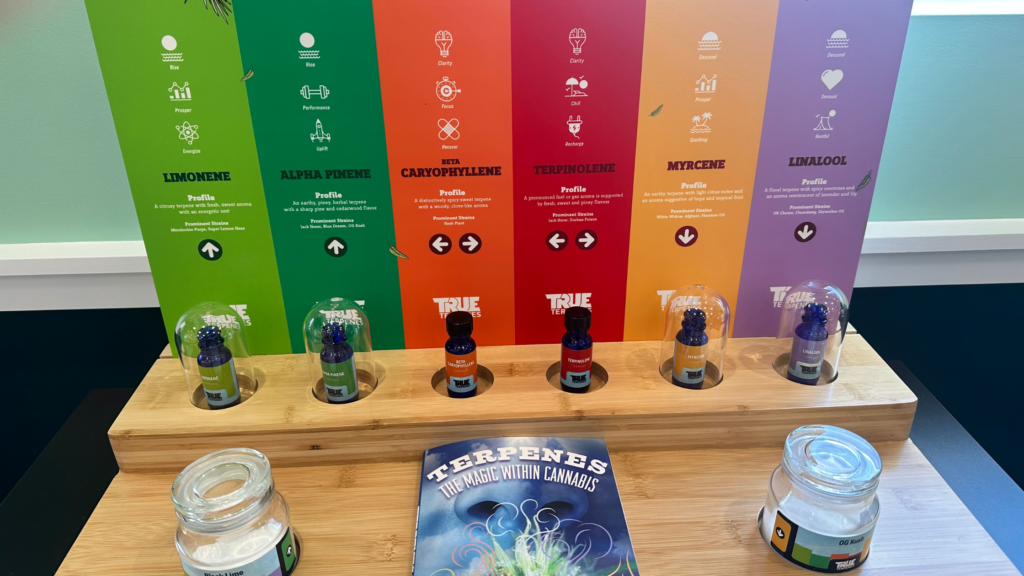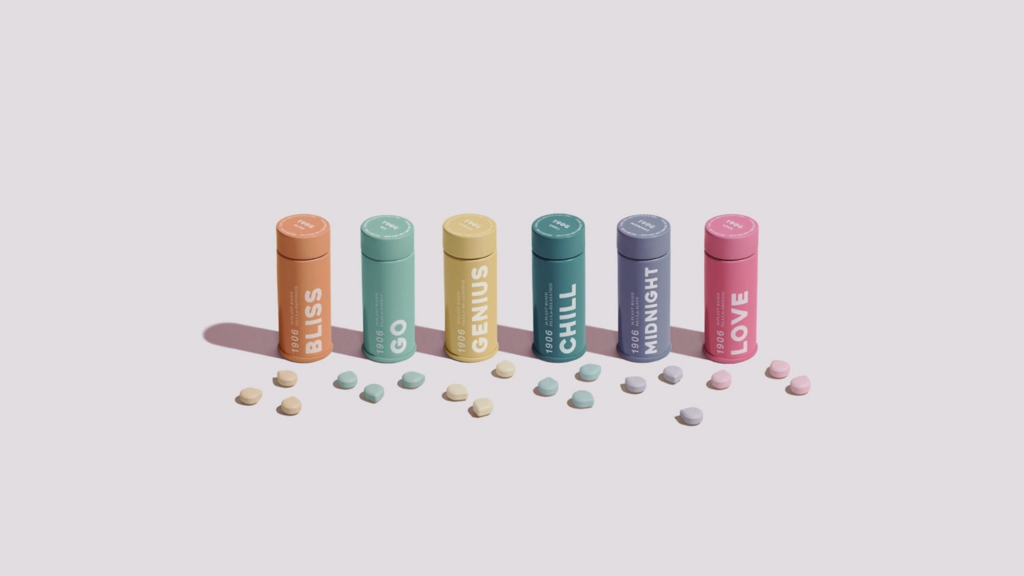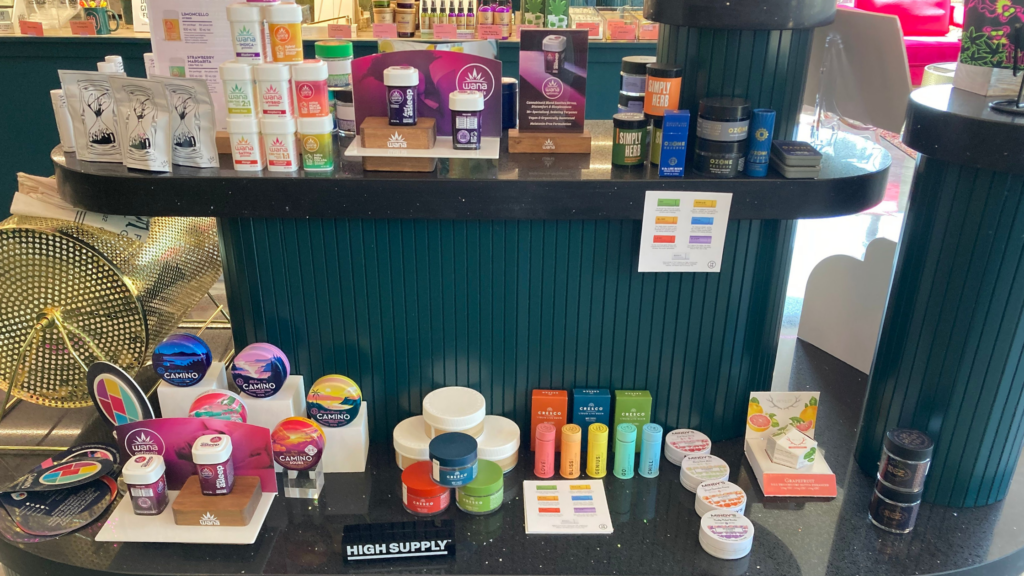With the medical and recreational legalization of cannabis quickly spreading across the country, it is no surprise that there is curiosity about the variety of products that are available to try.
Predominantly, they are marketed for their cannabinoid content, which is a range of chemical compounds found in plants like cannabis. Tetrahydrocannabinol, or THC, is perhaps the best-known of these compounds.
Still, while you may have heard of THC, you may not know how it works or understand all of its benefits. The friendly staff at your favorite sensory dispensary has amassed the most important information about THC.
THC Definition & Meaning
THC is a cannabinoid chemical with the scientific name tetrahydrocannabinol. It causes the majority of the psychoactive sensory effects you can experience if you use THC-containing cannabis (marijuana). While there are a few different chemical forms (isomers) of THC that are structurally similar, the predominant type of THC naturally found in cannabis is delta-9-THC.
How Does THC Work?

Let’s dive into the specifics of how THC works within the brain and body.
THC and the ECS
Since cannabinoid chemicals are also produced within the body to regulate many internal processes (these are known as endocannabinoids), the body also hosts a network of cannabinoid receptors to receive the unique messages provided by cannabinoids. THC binds with these receptors and influences the way they interact with chemicals to alter body and brain function.
Cannabinoid receptors are located in particular areas of the brain that handle memory, pleasure, thinking, and coordination. This network of receptors is known as the endocannabinoid system (ECS) and has additional receptors in locations throughout the body, such as the organs, muscles, digestive system, and skin. It is an important system, as it helps to promote healthy digestion and appetite, controls inflammation, and the workings of the immune system. The ECS also impacts your moods, body movements, and sleeping patterns.
Activating and Experiencing THC
Depending on the product you are using, THC may be in its precursor chemical form (THCA, or tetrahydrocannabinolic acid). For example, cannabis flower and some cannabis concentrates have natural THCA, a compound that must be heated to at least 210 to 240 degrees Fahrenheit to help the compound release a chain of carbon and oxygen, activating its psychoactive effects. This process, known as decarboxylation, is done by burning the cannabis or vaporizing the concentrate and inhaled as smoke or vapor. The THC found in edibles and oral products is typically decarbed in advance, so all you’ll need to do is ingest the cannabis.
When you smoke, ingest, or eat cannabis containing THC, the THC must be digested (in the case of edible products), pass through the thin skin under the tongue (in the case of tinctures), or be inhaled as smoke or vapor to pass through the lungs to the bloodstream beyond. The bloodstream takes the THC to the various parts of the body with ECS receptors. There, it binds to ECS receptors and triggers their function or alters the way they take action within the brain. These cannabinoid receptors are essential for modulating pain, pleasure, and more. In this way, cannabis containing THC can induce euphoric or pleasurable effects and can even reduce anxiety.
THC Benefits

THC, or tetrahydrocannabinol, is considered one of the most commonly found cannabinoids. It is frequently used to attain psychoactive effects like euphoria, but it is also popular for therapeutic effects like CBD.
THC is the principal compound ingredient that is responsible for marijuana’s effects on a person’s mental state and can be beneficial for improving mood and reducing anxiety. It also has several medical benefits, including controlling nausea and vomiting, increasing appetite in cancer patients receiving chemotherapy treatments, and increasing appetite. It has also been found to modestly reduce pain in people with chronic conditions such as rheumatoid arthritis, multiple sclerosis, cancer, and nerve damage.
Understanding THC: Where to Find THC
If you want to experience the sensory effects of THC, you’ll need to purchase a cannabis product containing THC. However, you may find these products have a few different names. Cannabis products are made from the Cannabis sativa L plant, but this umbrella term includes industrial hemp, which is bred to contain almost no THC. If you want THC, it’s crucial to look for marijuana, which is derived from the part of the plant with the most cannabinoid content– the cannabis flower.
Forms of Marijuana With THC
Whether it contains THC or not, cannabis can be found in different forms, such as flower, vape cartridges, concentrates, topical products, and more. The best known is likely flower, which is dried cannabis buds that are often ground and smoked. Concentrates are particularly potent forms of cannabis that frequently boast high THC content, as they are made by extracting the cannabinoid-rich oils from the plant. These can be vaporized and inhaled using a variety of methods.
Concentrates and flower can also be infused into food or drink, offloading THC into a variety of snacks and treats. Similarly, cannabinoids like THC can be infused into topical products like lotions, salves, balms, and even bath bombs.
Top THC Products

As the predominant cannabinoid of interest for those seeking pleasurable sensory effects, THC is a key compound in nearly every product on our shelves. Here at Ivy Hall, we partner with only the best brands to stock a wide variety of THC products, so there is a high-quality option for cannabis enthusiasts of all types.
Of course, the traditional way to experience THC is to smoke marijuana flower, and you’ll find a broad selection of buds, loose flower, and even pre-rolls at your local sensory dispensary. We also stock a wide assortment of vape cartridges in various strains, flavors, and potencies. One of our most popular THC product types is cannabis edibles, available here in gummies, chocolates, and even crispy treats.
If you are looking for more of the best THC products in Illinois, visit any Ivy Hall Dispensary location to browse our selection.
How To Read a Cannabis Product Label
If you’re looking for a superb sensory experience, it’s important to know what to expect once you use your chosen cannabis product. Reading the label is the best way to learn about cannabis and prepare yourself for the experience to come. Here’s how to do it.
- Look for the cannabis symbol – This symbol indicates that this is an officially vetted cannabis product containing THC.
- Check out the brand – Companies must include the brand name or other branding images. As you become familiar with your favorite brands, you can select those that have the quality and values you want.
- Look for cannabinoid content – You’ll see THC and CBD concentrations listed here, as a percentage of mg THC or other cannabinoids per gram of flower. Edibles will list total mg of THC and other cannabinoids per package or per serving. Many products will list ratios of THC to CBD and other cannabinoids.
- Consider health warnings – Most cannabis products carry a warning label.
- Evaluate additional information – Companies are required to list strain, expiration and packaging dates, product weight, storage directions, and uses, as well as producer information. They may also include directions and other product information.
- Read nutrition facts – If you’ve picked up an edible product, you’ll see nutrition facts just like any other food product.
- Consider the ingredients list – Any product but cannabis flower must list all other ingredients, as well as any potential allergens.
Different Kinds of Cannabinoids
Of course, THC is not the only cannabinoid, as hundreds of cannabinoids have been identified – at least 113 of them in the cannabis plant alone. You’ll find an increasing number of other cannabinoids listed on many product labels as researchers discover additional benefits.
When ingested, cannabinoids can be useful in treating many ailments, including treating certain kinds of epilepsy, keeping nausea and vomiting at bay after receiving chemotherapy treatments, easing symptoms from multiple sclerosis, and preventing weight loss for those with HIV/AIDS. There also may be health benefits to taking cannabinoids for consistent pain, anxiety, irritable bowel syndrome and inflammatory bowel disease, sleeping issues, and even those who experience Post Traumatic Stress Disorder (PTSD).
Below are some of the more popularly used cannabinoids.
CBN
Cannabinol, or CBN, is a cannabinoid present in the cannabis flower. It is produced when tetrahydrocannabinolic acid – a precursor for THC – degrades, and it has mild psychological effects. CBN appears to offer many benefits, such as providing antibacterial properties, easing inflammation, and promoting sleep.
CBD
Cannabidiol (CBD) is a well-known cannabinoid that you can find in a vast array of cannabis products, such as gummies, lotions, and oils. It is often used to decrease inflammation and may help those with arthritis and other inflammatory conditions.
CBDA
Cannabidiol acid (CBDA) is the precursor for CBD and is primarily produced in the seed oil of the hemp plant. It may help decrease inflammation, ease nausea, stop vomiting, and impact the serotonin levels in the body. This can result in better sleep, a boost in moods, and appetite regulation.
THCV
Tetrahydrocannabivarin, also known as THCV, may provide relief for health issues like inflammation and chronic pain. It may even help with decreasing appetite, preventing obesity, and promoting weight loss. It is also potentially beneficial for those with PTSD and other mental health issues such as depression, anxiety, and neurological disorders.
CBC
Cannabichromene, or CBC, is not as well studied as other cannabinoids but still has several benefits that show research potential. One study by the National Library of Medicine has demonstrated that it has helped decrease inflammation in the intestines of animals, spurring treatments for inflammatory issues (such as constipation), inflammation of the intestines, and cancer.
CBG
Cannabigerol, or CBG, is known as the mother cannabinoid because it is a precursor to many other kinds of cannabinoids. It has several healing properties for inflammation, lessens eye pressure, and can serve as an antibacterial agent. Benefits of using CBG include helping with anxiety, promoting healthy skin, protecting the brain, and maintaining a healthy appetite.
CBGA
The advantages of using CBGA are still being researched, but it is understood to have properties that decrease inflammation and provide protection for the brain. In a study by the National Institutes of Health, CBGA was shown to stop kidney inflammation in mice that were initially given chemotherapy medication that usually causes kidney issues. From this study, it is believable that this cannabinoid can assist in promoting kidney health.
Understanding THC FAQs
At Ivy Hall, we field many questions about all the most common cannabinoids, including THC. Here are some of the most frequent:
What Is THC?
THC, or tetrahydrocannabinol, is a cannabinoid chemical compound found in the cannabis plant. It interacts with the endocannabinoid receptors found in the brain and body, influencing the human endocannabinoid system to affect memory, sleep, pleasure, thinking, and more. THC causes the psychoactive effects cannabis is known for, but it can also have therapeutic effects on pain, anxiety, reduced appetite, and other conditions.
Is Marijuana the Same Thing as Cannabis?
While marijuana and cannabis are often used interchangeably, there are important differences you should be aware of. Cannabis is an umbrella term typically used to refer to all products that are made from the Cannabis sativa L plant. Marijuana is cannabis taken from the flowering part of the Cannabis sativa plant that contains large amounts of THC. Industrial hemp, by contrast, is Cannabis sativa L bred to contain extremely low THC content, so it is not marijuana, but it is cannabis.
What Is Considered High THC?
High-THC cannabis is cannabis with a high concentration of THC per dose. Typically, cannabis content over 15% (or over about 25 mg for an edible) is considered a high-THC product. However, it is important to note that “high THC” can be a relative term.
Note that cannabis with a wide range of THC concentrations is available to ensure everyone achieves the sensory experience they desire. Those who prefer stronger concentrations may purchase products with cannabis concentrations upwards of 35% for flower and 50 mg for edibles, while those who want a mild product can find cannabis products that contain under 5% or 2.5 mg.
What Does THC Percentage Tell You?
The THC percentage refers to the concentration of THC found in a particular cannabis product. For flower and vape cartridges, it refers to the milligrams of THC per gram, though edibles list the total milligrams of THC in a dose of the product. Concentration can vary depending on the type of product or the strain, but higher percentages always mean higher concentrations and a more potent product per dose, with lower percentages indicating lower concentrations and a milder product per dose.
CBD vs. THC: What’s the Difference?
CBD and THC are both cannabinoid compounds derived from the cannabis plant, and they are frequently found together in popular cannabis products. However, they are not the same. CBD, or cannabidiol, modulates the way the body’s cannabinoid receptors interact with other cannabinoids and can create therapeutic effects like pain and anxiety relief without producing a high. THC, or tetrahydrocannabinol, is what causes the euphoric feeling many people seek when consuming cannabis, and it does so by binding with cannabinoid receptors to influence mood, pleasure, sleep, and cognition.
Find Effective Cannabis Products by Shopping at Ivy Hall

At Ivy Hall, we are proud to feature a curated selection of THC-forward products for all occasions. Depending on your desires, you can find a cannabis product to create a sensory experience, provide therapeutic benefits, or both. Whether you are looking to learn more about finding your sensory niche or the benefits of all the various cannabinoids in our favorite plant, we are here to answer your questions and guide you in the right direction.
Please don’t hesitate to contact us online or visit your local Sensory Dispensary, where you can find an educated team member who can share their knowledge and help you find the answers you are seeking.
Sources:
- Live Science. (n.d.). What is THC?. Retrieved from
https://www.livescience.com/24553-what-is-thc.html - National Center for Complementary and Integrative Health. (n.d.). Cannabis (marijuana) and cannabinoids: What you need to know. Retrieved from
https://www.nccih.nih.gov/health/cannabis-marijuana-and-cannabinoids-what-you-need-to-know - Pertwee, R. G. (2012). Targeting the endocannabinoid system with cannabinoid receptor agonists: Pharmacological strategies and therapeutic possibilities. Philosophical Transactions of the Royal Society B: Biological Sciences, 367(1607), 3353-3363.
https://www.ncbi.nlm.nih.gov/pmc/articles/PMC3417459/ - van der Molen, T., & de Vries, M. (2023). The emerging role of cannabinoids in clinical practice. Frontiers in Medicine.
https://www.ncbi.nlm.nih.gov/pmc/articles/PMC10113213/ - National Library of Medicine. (2020). Cannabinoid medications and their pharmacology. In Cannabis and cannabinoids: Pharmacology, toxicology, and therapeutic potential. Retrieved from
https://www.ncbi.nlm.nih.gov/books/NBK563174/ - National Library of Medicine. (2020). Delta-9-tetrahydrocannabinol (THC): Pharmacology and therapeutic use. In Cannabis and cannabinoids: Pharmacology, toxicology, and therapeutic potential. Retrieved from
https://www.ncbi.nlm.nih.gov/books/NBK563174/#:~:text=Delta%2D9%2Dtetrahydrocannabinol%20(also,the%20class%20of%20cannabinoid%20medications
